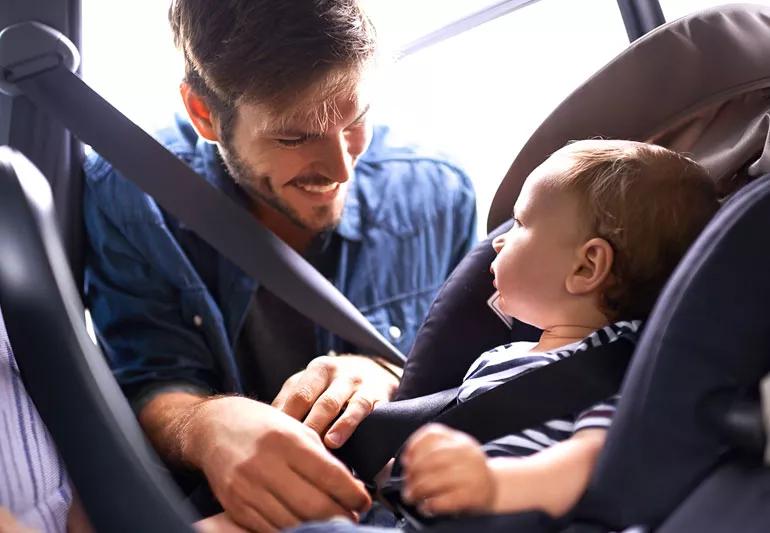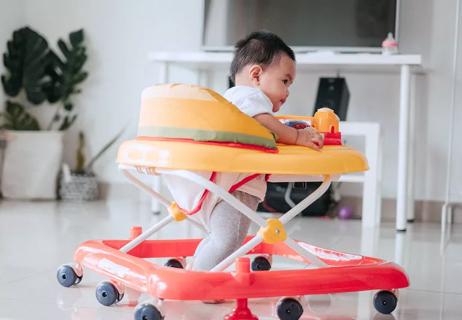Get the answer along with tips for safe installation

As a parent, you celebrate each milestone your child achieves — sitting up, crawling, taking first steps and saying their first word. But graduating to a front-facing car seat? That’s one such milestone that shouldn’t be rushed, according to guidelines from the American Academy of Pediatrics (AAP).
Advertisement
Cleveland Clinic is a non-profit academic medical center. Advertising on our site helps support our mission. We do not endorse non-Cleveland Clinic products or services. Policy
For years, parents have learned that keeping their child rear-facing in a car seat until age 2 is the best practice. But that recommendation has since been updated and now suggests that parents keep their children in rear-facing seats for as long as possible.
Purva Grover, MD, Director of Cleveland Clinic Children’s Pediatric Emergency Departments, says a child in a rear-facing seat has less risk for serious (or fatal) injury if involved in a crash.
“Because of the way their head and neck is positioned, when there is a big car crash involving a massive force — if they were to be front-facing, the positioning of the head and neck would give them bad whiplash, and with small children, it could actually cause much more damage,” Dr. Grover explains.
There are a few options when it comes to rear-facing seats.
As the name implies, all-in-one seats have multiple uses. They can be used as a booster seat, a rear-facing seat or a forward-facing seat. However, they should only be used for car rides. All-in-one seats don’t have handles or bases. They’re also much larger in size and have higher weight and height limits than other styles of rear-facing seats. If you decide to buy an all-in-one car seat, make sure it’ll fit in your car when it’s rear-facing as it’s a bigger seat.
Advertisement
With these seats, you can start off using them as rear-facing and then transition to forward-facing when your child outgrows the weight and height limits for rear-facing seats. Convertible seats tend to be larger than rear-facing seats and they don’t have carrying handles or bases. They also tend to have a five-point harness that attaches between the legs and at the hips and shoulders.
These seats are small and can carry infants between 22 and 35 pounds or 26 and 35 inches. Rear-facing only seats tend to have a base that stays in the car. However, rear-facing seats should only be used for travel and not for sleep or feeding times.
Here are a few things to keep in mind when placing a rear-facing car seat in your vehicle.
The car seat harness should be at or below your little one’s shoulders. Once situated, it should be snug. The harness’ chest clip should be in the middle of your child’s chest and lined up with their armpits.
If the airbag for the front passenger’s seat is active, don’t put a rear-facing car seat there. Doing this could lead to serious injuries or even death. The reason being is if the airbag inflates, it’ll knock the car seat into your child’s head or worse.
For rear-facing convertible or all-in-one seats, make sure the seat belt or lower anchor webbing is in the correct belt path. If you’re not sure, review the instructions.
To ensure that your child’s head doesn’t flop around, refer to the manual for the right seat angle. Once you find it, adjust the seat as needed.
If you need help with car seat installation, a Child Passenger Safety Technician (CPST) can make sure that it’s properly secured and ready for use.
According to the AAP and the National Highway Traffic Safety Administration (NHTSA), children up to 3 years old should stay in a rear-facing car seat until they reach the top height or weight limit suggested by the car seat’s manufacturer. When your child hits one of these limits, they can ride in a forward-facing car seat with a harness and tether.
According to the Centers for Disease Control and Prevention (CDC), car accidents are a leading cause of death for children in the U.S. In 2019, more than 600 children age 12 and younger died in motor vehicle crashes, and more than 91,000 were injured.
However, the CDC also states that car seat use reduces the risk for injury in crashes by 71% to 82% for children, when compared with seat belt use alone.
The updated recommendations also say that once a car seat has been turned around, it should remain forward-facing until your child reaches the seat’s weight and length limits. Then, your child should start using a booster seat. Children who exceed booster seat limits should use a lap and shoulder seat belt in the back seat of the car until they’re 13 years old.
Advertisement
Dr. Grover agrees with the recommendations and says that when it comes to minimizing injury risk, safety should always come before convenience. She adds that it’s important for pediatricians to talk to parents about the guidelines and explain why they’re in place. The complete recommendation is available through the American Academy of Pediatrics.
Advertisement
Learn more about our editorial process.
Advertisement

It’s never too early to teach your kids who strangers are and how to avoid unsafe situations

An ounce of prevention ... is worth a great school year!

Talk with your kids about online risks, and consider monitoring their activity

Many cosmetic products can cause poisoning and chemical burns

The answer is a definite NO, given the risk of injury and even death

Thousands of head and neck injuries occur every year

Specific symptoms will warrant a trip to the emergency room

How to keep your little one warm and safe in the car

Type 2 diabetes isn’t inevitable with these dietary changes

Applying a hot or cold compress can help with pain